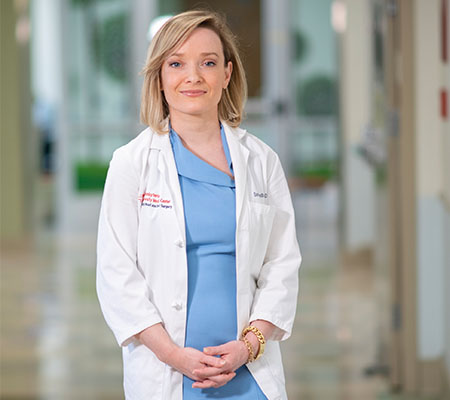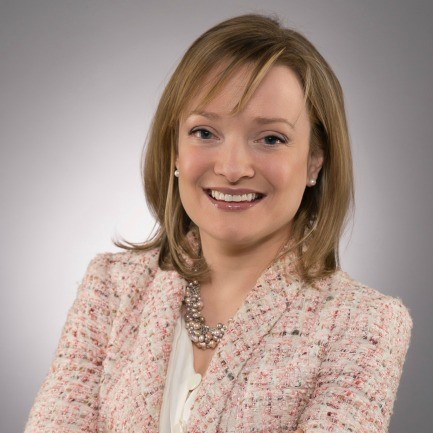Some 34 percent of patients on mechanical ventilation for more than 48 hours undergo tracheostomy, amounting to more than 100,000 patients in the United States each year. Despite the common incidence of this practice, little attention has been given to tracheostomy aftercare. At NewYork-Presbyterian/
Dr. Susannah Hills
To deal with the overwhelming burden of tracheostomy patients and increased risk of postoperative complications, faculty in the Department of Otolaryngology – Head and Neck Surgery at Columbia, led by Susannah Hills, MD, a pediatric otolaryngologist with expertise in airway surgery and aerodigestive disorders, developed the Safe Tracheostomy Aftercare Taskforce (STAT) Team. Comprised of military personnel, physician assistants, and residents directly supervised by an attending physician, the STAT team created standardized tracheostomy care guidelines for postoperative care, instituted a rounding structure, and provided inpatient care teams with education interventions.
The STAT team began care on postoperative day (POD) 1, evaluating the patient and establishing contact with the patient care providers. In addition, the team:
- Ensured that all appropriate care equipment was at bedside
- Followed the patient daily until the first tracheostomy tube change
- Educated the healthcare team on standardized tracheostomy care guidelines
On POD4, the STAT team revisited their recommendations with providers to close any educational gaps, and on POD7, the team would perform inner cannula changes, remove sutures, and exchange tracheostomy ties.
We are the only institution we are aware of that created this team as a direct response to the burdens of the COVID-19 pandemic on our hospital system. Given the clear benefits of our STAT team, we advocate for continued tracheostomy care measures, not only in our hospital system but as a generalized approach to tracheostomy management in other healthcare systems as well.
— Columbia Safe Tracheostomy Aftercare Taskforce Team
The STAT team also responded to tracheostomy-related issues, such as cuff leaks, stoma bleeds, and wound care issues. They prioritized a tracheostomy weaning pathway, including managing tube size adjustments, facilitating use of speaking valves, and designing and implementing a capping protocol, which, upon completion, resulted in decannulation. The team also coordinated post-discharge follow-up via video visit for each patient within two months following discharge.
“On a typical day during the pandemic, the rotating surgical and anesthesia teams would go from patient to patient at bedside – sometimes as many as seven or eight – surgically entering the airway and placing the tracheostomy tube,” notes Dr. Hills. “The other surgical team members, along with physician assistants and residents, would go from bed to bed, checking on the patients who already underwent surgery, making sure their tubes were secure and that they had the supplies they needed nearby.”
“Our goal was to keep patients safe after surgery and then to discharge them either to their home or more often to a rehabilitation facility without the trach tube,” she continues. “A major objective of this effort was also to address related quality-of-life issues, such as swallowing and voice and working towards decannulation when it’s possible.”
Gauging Effectiveness of the STAT Team
To quantify and understand the benefits of the STAT team on the outcomes of tracheostomy care, the NewYork-Presbyterian/Columbia team collected retrospective data from tracheostomy patients in the hospital from February to June 2019, which was prior to creation of the STAT team. This data was then compared to prospectively collected data from tracheostomy patients from February to June 2020, when the STAT team was in place. A total of 170 patients underwent tracheostomy and were cared for by the STAT team. This included 106 males (62 percent) and 64 females (38 percent), averaging 60.9 years old (range 23 to 91 years). The primary endpoint was decannulation before discharge with secondary endpoints that included time to first tracheostomy change, incidence of appropriate tracheostomy change when indicated, and time to outpatient follow-up. The results of their review, which were published in the January-February 2022 issue of the American Journal of Otolaryngology, found that the STAT team significantly increased:
- rate of decannulation prior to discharge (P < 0.0005);
- performance of tracheostomy tube change when indicated (P < 0.05); and
- rates of follow-up for tracheostomy patients after discharge from the hospital (P < 0.0005).
Dr. Hills, who served as lead author on the study, and her STAT team colleagues, concluded: “Tracheostomies require complex monitoring and interventions that can be overlooked in busy hospital settings by teams charged with a diversity of responsibilities. The success of the STAT team demonstrates how useful a single-focus team can be in bridging gaps in care for patients of such a common, high-acuity procedure. The significant benefits provided by the STAT team despite the limitations and challenges of operating in the middle of the pandemic further suggests that there may be larger benefits to such a tracheostomy care team during non-pandemic times, strengthening the argument for permanent implementation and continuation of such single-focus care teams.”





